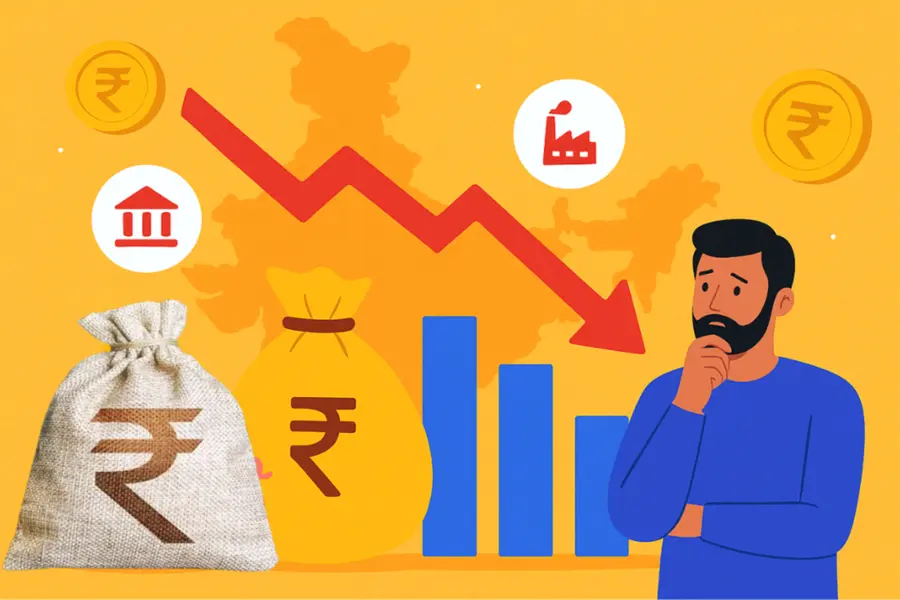India’s economic strength has long relied on its people’s ability to save. But with the household savings rate dropping below 20% of GDP, a worrying trend is emerging.
Rising living costs, easy credit, and lifestyle changes are reshaping how Indians manage money. This fall in savings threatens economic growth, investment, and financial stability.
In this article, we’ll explore the causes, effects, and solutions of India’s declining savings trend — from rising living costs and lifestyle changes to policy reforms and digital financial inclusion.
Understanding the effects of low household savings isn’t just about numbers — it’s about the future of a nation aiming for sustainable, self-reliant growth.

What Are the Effects of Low Household Savings on Growth in India? Causes, Impacts and Solutions
Low household savings can weaken India’s economic growth by reducing investment, productivity, and financial stability. Learn about its causes, effects, and policy solutions.
Introduction: The Role of Savings in Economic Growth
Savings are the silent engine that keeps an economy moving. When people save, those funds flow into banks, businesses, and investments — fueling growth, job creation, and innovation.
For decades, India was known for its strong savings culture; families prioritized security over spending, often saving a big share of their income. But in recent years, this trend has reversed.
According to the Reserve Bank of India, the household savings rate has dropped below 20% of GDP — the lowest in decades.
Rising living costs, easy credit, and changing lifestyles are reshaping how Indians handle money. While spending boosts short-term demand, low savings can weaken the long-term foundation of economic growth.
Without enough domestic savings, India risks depending more on foreign capital and facing slower, less stable progress.
Understanding why savings are falling — and how it impacts growth — is key to keeping India’s economic engine running strong.
Understanding Household Savings in India
Household savings simply mean the portion of income that families set aside after meeting their daily expenses. These savings can be in financial assets—like bank deposits, insurance policies, mutual funds, and pensions—or in physical assets, such as gold, real estate, and land.
In India, both forms play a big role, but traditionally, households have shown a strong preference for tangible assets like gold and property, which feel safer and more familiar than stocks or bonds.
Over the last two decades, however, India’s savings pattern has changed. As incomes have grown slowly while living costs have surged, many families are finding it harder to save.
The rise of consumer credit, easy EMIs, and lifestyle spending has also shifted focus from saving to spending.
Rural households often save through land or livestock, while urban families lean toward financial assets—but both face mounting financial pressure.
According to RBI’s Handbook of Statistics on the Indian Economy and NSO data, India’s household savings rate has declined significantly over the past decade — from above 25% of GDP in the early 2010s to below 20% in recent years. This decline signals more than just changing habits—it highlights a deeper challenge for India’s growth story.
When families save less, the pool of money available for investments and development shrinks.
Understanding where and why household savings are falling helps policymakers design better strategies to strengthen financial security and ensure that India’s growth remains steady and self-reliant.
Causes of Low Household Savings in India
India’s low household savings aren’t just a result of poor planning — they reflect the everyday struggles of millions of families.
The high cost of living has become a major hurdle. Urban housing prices, skyrocketing education fees, and rising healthcare expenses leave little room for saving after essentials are paid for.
Add to that persistent inflation, and even basic goods eat up a bigger share of household budgets.
At the same time, income growth has slowed, especially for the middle and lower-income groups who make up most of India’s population.
When salaries don’t keep up with prices, saving becomes a luxury. Meanwhile, consumerism and the easy availability of credit have changed spending habits.
The “EMI lifestyle” — buying now, paying later — makes it tempting to spend future earnings today, reducing savings further.
Another big challenge is job insecurity, especially in the informal sector, which employs over 80% of India’s workforce. Without stable income or social security, families prefer liquidity over long-term savings.
Finally, tax and interest rate structures haven’t helped much — low returns on savings accounts and limited tax incentives discourage people from locking away their money for the future.
All these factors combined have created a cycle where most households spend nearly everything they earn.
Reversing this trend will require policies that make saving easier, safer, and more rewarding — because a nation’s economic strength begins with the financial security of its people.
Effects of Low Household Savings on Economic Growth
Low household savings might seem like a personal issue, but when millions of families save less, the effects ripple across the entire economy.
Savings are the foundation of long-term growth — they fund investments, create jobs, and build resilience. When this foundation weakens, India’s growth engine starts to slow down. Here’s how low savings affect the broader economy:
a. Reduced Domestic Investment
Savings are the fuel for investment. When households save more, banks and businesses can channel that money into factories, startups, and infrastructure. But when savings fall, the domestic pool of capital dries up. India then has to rely more on foreign investment to fill the gap — a risky dependency that leaves the economy vulnerable to global financial shocks and instability.
b. Pressure on Financial Institutions
Household savings are the lifeblood of banks. Fewer deposits mean less money for banks to lend to businesses, industries, and consumers. This liquidity crunch slows credit growth and raises borrowing costs. With limited funds, small and medium enterprises — the backbone of job creation — struggle to expand, ultimately weakening the entire economic ecosystem.
c. Slower Infrastructure & Industrial Growth
Large-scale projects like highways, renewable energy parks, and industrial zones need massive funding. When domestic savings decline, financing these long-term projects becomes difficult. Investors turn cautious, progress slows, and fewer jobs are created. As infrastructure growth weakens, productivity dips and India’s overall competitiveness on the global stage takes a hit.
d. Increased External Borrowing & Fiscal Deficits
When internal savings aren’t enough to support development, the government borrows from abroad. This increases external debt and can lead to fiscal deficits. Heavy borrowing also pushes up interest rates, “crowding out” private investors. Over time, higher debt repayment costs strain public finances and make the economy more vulnerable to inflation and currency fluctuations.
e. Social Impacts
Beyond numbers, low savings affect people’s lives. Families with little financial cushion are more exposed to emergencies like medical bills or job loss. This reduces overall economic confidence and discourages spending on long-term goals like education or entrepreneurship. A society with weak household savings becomes less resilient — both financially and emotionally — during economic downturns.
When savings fall, growth, stability, and confidence all take a hit. Building a stronger savings culture isn’t just about securing households — it’s about securing India’s economic future.
Policy Measures and Possible Solutions
Reversing India’s declining household savings requires smart policies that make saving simple, rewarding, and accessible for everyone.
One key step is financial literacy and inclusion. Many households, especially in rural areas, still rely on informal saving methods. Promoting awareness about digital savings tools, UPI-linked accounts, and government-backed small savings schemes like Sukanya Samriddhi Yojana or PPF can help more people save securely and earn better returns.
Another important lever is tax incentives. Expanding Section 80C benefits and allowing deductions for a wider range of investments—like mutual funds, NPS, or health insurance—can motivate individuals to invest for the long term.
Alongside this, pension and insurance coverage need a stronger push. Wider participation in schemes such as Atal Pension Yojana and affordable life or health insurance can provide stability, especially for informal workers.
Maintaining inflation control and stable interest rates is equally vital. When prices rise faster than interest earned, people lose trust in financial savings and turn to gold or property. A stable macroeconomic environment helps restore that confidence.
Empowering women in finance can transform India’s savings landscape. Women are often natural savers; encouraging them to open bank accounts, invest, and participate in household financial decisions can significantly boost total savings.
These measures can rebuild India’s savings habit—strengthening families’ financial security while fueling the nation’s long-term economic growth. A financially aware and confident population is the surest path to a self-reliant India.
Future Outlook: Can India Rebuild Its Savings Culture?
India’s future growth story depends on how quickly it can revive its culture of saving — and technology is already leading the way.
FinTech platforms, digital wallets, and UPI-linked saving apps have made managing money easier than ever.
From micro-investment tools to automatic saving features, these innovations are helping even first-time users develop consistent saving habits.
But technology alone isn’t enough. The mindset of India’s youth will play a crucial role. Today’s generation is more focused on lifestyle spending, but there’s a gradual shift toward investing — in mutual funds, SIPs, and startups.
Social media influencers, financial educators, and easy-to-use apps are making personal finance cool and accessible, changing how young Indians think about money.
To truly sustain this momentum, India needs inclusive growth backed by domestic capital.
Relying on foreign funds makes the economy vulnerable, but strong household savings create a stable foundation for long-term development.
Encouraging saving, rewarding investment, and ensuring that growth benefits every section of society can make India’s economy more resilient and self-reliant.
Rebuilding the savings culture isn’t just about numbers — it’s about empowering citizens to secure their future while fueling the nation’s progress, one rupee at a time.
Read Also: The Economic Impact of Child Labor in India
Conclusion: Savings as the Foundation of Self-Reliant Growth
Economic growth without savings is like building a skyscraper on sand — it might rise fast, but it won’t stand strong for long.
Savings are the silent strength behind every stable economy, providing the capital that fuels investment, innovation, and resilience. For India, rebuilding this foundation is essential to achieve self-reliant, sustainable growth.
While spending drives demand and keeps markets alive, balanced policies that encourage both consumption and saving are crucial.
India needs to make saving easier, more rewarding, and part of everyday life — through better financial literacy, digital inclusion, and incentives for long-term investments.
When households feel secure and confident about their future, they contribute more meaningfully to the nation’s economic progress.
The journey toward a stronger India begins not just in factories or boardrooms, but in the homes of ordinary families choosing to save for tomorrow.
India’s true growth story will be written not just by how much we earn — but how wisely we save.





